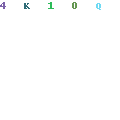Entries in Review (26)
Prime Condition: Great Workout Mixes
 Music is a terrific motivator while working out and a new service called Prime Condition (beta) takes it to the next level. The service allows you to design your own workout routine and download a customized mp3 mix. The unique thing about prime Condition is that the workout mix contains a female voice-over that instructs you throughout your workout. The voice provides basic instructions on good form, counts your reps, tells you when to rest, and informs you on what’s coming next.
Music is a terrific motivator while working out and a new service called Prime Condition (beta) takes it to the next level. The service allows you to design your own workout routine and download a customized mp3 mix. The unique thing about prime Condition is that the workout mix contains a female voice-over that instructs you throughout your workout. The voice provides basic instructions on good form, counts your reps, tells you when to rest, and informs you on what’s coming next.
You create workouts using a cool Web 2.0-style configuration tool. You build a routine by selecting exercises from a set of body area specific menus. For each exercise you can set the number of reps, rep speed and rest time. As you continue to build your workout routine, the service displays the workout’s total time. If you want to mix cardio into your routine, there is an intuitive time-based UI that allows you to adjust the intensity level. For instance after five minutes of biking you can increase intensity, after the next five minutes increase it more, etc. Once you have designed your workout, Prime Condition will let you mix a playlist and generate a downloadable mp3 file with your new workout.
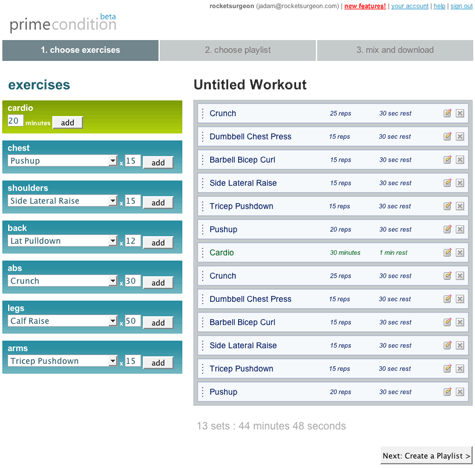
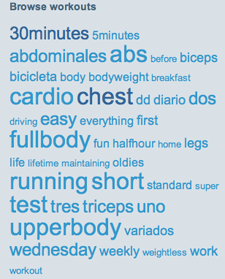 The service provides a free tier that limits your workout to 45 minutes and uses their own music for your mix. For $9 a month you can upload your own mp3s, get queue priority, and encode higher quality workouts. You can also make your workouts public and browse workouts from other members via a tag cloud. The UI is clean and simple but sould use some better organization and consistency. Unfortunately, it does not seem like there is an easy way to share/email your workouts with another person. If you already use a portable player when working out, and are looking for a little extra motivation, you may want to Prime Condition a spin.
The service provides a free tier that limits your workout to 45 minutes and uses their own music for your mix. For $9 a month you can upload your own mp3s, get queue priority, and encode higher quality workouts. You can also make your workouts public and browse workouts from other members via a tag cloud. The UI is clean and simple but sould use some better organization and consistency. Unfortunately, it does not seem like there is an easy way to share/email your workouts with another person. If you already use a portable player when working out, and are looking for a little extra motivation, you may want to Prime Condition a spin.
Check out my workout mix…
The Filter Playlist Generator: Review
 I recently used a very cool Last.fm analysis tool to check out my listening behavior. To my surprise, 50% of my listening was from my top 25 artists even though I have 7300 artists in my iTunes library. Of course I can just use shuffle or create manual/smart playlists to expose myself to more of my own music. However, sometimes you just want to create a playlist without the hassle of hand-picking songs or configuring smart playlist parameters. I recently discovered The Filter, a promising tool for iTunes and Windows Media Player, that automatically creates playlists based on artists, genres or individual songs.
I recently used a very cool Last.fm analysis tool to check out my listening behavior. To my surprise, 50% of my listening was from my top 25 artists even though I have 7300 artists in my iTunes library. Of course I can just use shuffle or create manual/smart playlists to expose myself to more of my own music. However, sometimes you just want to create a playlist without the hassle of hand-picking songs or configuring smart playlist parameters. I recently discovered The Filter, a promising tool for iTunes and Windows Media Player, that automatically creates playlists based on artists, genres or individual songs.
Download and install The Filter application on your hard drive (Mac and PC versions available). After you complete a basic, free registration form, The Filter scans your iTunes library. I have about 23,000 songs in my library and the entire scanning process took just under 10 minutes. To create a playlist, just select three songs from your iTunes library and click the “F” button. You can base the resulting playlist by your selected songs, artists or genres. The Filter then generates a playlist of songs from your iTunes library based on matches in their community database.
To test the product I selected three songs from my Jazz genre and set the playlist to match the songs. The resulting playlist (shown below) was pretty much spot-on. The Filter allows you to set the number of tracks for a playlist and expand your playlist once it is created. I do wish there was the ability to restrict the playlist from repeating artists and songs from the same album.
One your playlist has been created you can use The Filter to explore album reviews and recommendations for the music in your playlist. You can then purchase recommended songs at the store of your choice (Amazon, iTunes, eMusic, MSN, etc.)
The Filter also provides you with a personal profile page on their web site that provides you with recommendations, artist bios, album reviews, and YouTube videos. However, when I tried accessing my page, there was no information on it. Worse, they failed to provided a reason why nothing was showing up.
There are also some funky UI issues with The Filter (on my Mac). The application window has a problem moving to the background when other applications are active and sometimes disappears when you switch over to iTunes. Even though I selected for song info to automatically display for now playing songs, the application doesn’t refresh the content in the more info window. Personally, I think The Filter would be much better if it was integrated into iTunes, similar to the iLike sidebar. Aside from some of the bugginess of the program, The Filter does a pretty good job when it comes to its primary function - creating good playlists based on limited inputs.
SpotDJ: Innovative Radio-Style Experience for iTunes
 Do you ever pine for the days when listening to the radio was a great experience? The days of knowledgeable DJs who really knew what they were talking about? DJs who had passion for the music they were playing and knew about the musicians and their influences? When bands would come on the radio and discuss their songs and what they mean? Those days may be gone for terrestrial radio, but a new Music 2.0 service called SpotDJ is taking the concept to the next level.
Do you ever pine for the days when listening to the radio was a great experience? The days of knowledgeable DJs who really knew what they were talking about? DJs who had passion for the music they were playing and knew about the musicians and their influences? When bands would come on the radio and discuss their songs and what they mean? Those days may be gone for terrestrial radio, but a new Music 2.0 service called SpotDJ is taking the concept to the next level.
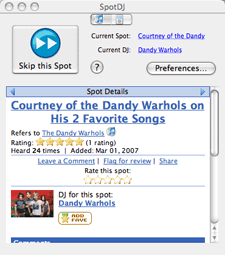 SpotDJ is a web site and downloadable application that delivers a unique radio DJ style experience to iTunes playback. Members of the SpotDJ community record their own audio spots based on individual songs and artists. After listening to a song in iTunes, instead of going directly to the next song, you hear a relevant spot about the song or artist you just heard (assuming a spot exists in the database). For instance, I decided to listen to some Dandy Warhols today to test out the service. After the first song finished playing, I was very surprised to find out that Courtney Taylor-Taylor himself recorded a spot about his favorite songs. As I listened to more songs there were more spots by Courtney about touring, how the band got their name, and his influences. How cool is that? As another test, I listened to the Beastie Boys Paul’s Boutique. Sure enough after each song, I got spots that discussed the individual songs, the band and where all the samples came from.
SpotDJ is a web site and downloadable application that delivers a unique radio DJ style experience to iTunes playback. Members of the SpotDJ community record their own audio spots based on individual songs and artists. After listening to a song in iTunes, instead of going directly to the next song, you hear a relevant spot about the song or artist you just heard (assuming a spot exists in the database). For instance, I decided to listen to some Dandy Warhols today to test out the service. After the first song finished playing, I was very surprised to find out that Courtney Taylor-Taylor himself recorded a spot about his favorite songs. As I listened to more songs there were more spots by Courtney about touring, how the band got their name, and his influences. How cool is that? As another test, I listened to the Beastie Boys Paul’s Boutique. Sure enough after each song, I got spots that discussed the individual songs, the band and where all the samples came from.

If there is no spot for a specific song, SpotDJ will see if there is a spot for the artist. If there is neither you wont hear a spot. Once all spots for a particular artist have been heard, the system is smart enough to know not to play them again. Want the experience on the go? SpotDJ can also attach spots to playlists on your iPod. You also have the ability to comment on individual spots, send member messages and email/embed spots. So there’s no spot for your favorite song? SpotDJ provides a variety of methods to record your own spots - via microphone, uploading an mp3 and even via phone.
Aside from some needed UI tweaks, SpotDJ is hands-down one of the coolest Music 2.0 services I have ever seen.
Audiobaba: Trait-Based Recommendations
 Audiobaba is a simple and elegant music search and recommendation engine. Most recommendation engines provide song matches based on related artist data (artist X is similar to artist Y) and collaborative filtering (people who listen to X listen to Y). Audiobaba takes a different approach. Every song in the Audiobaba database is “fingerprinted” with acoustic characteristics and other special-sauce qualities. When you search for a song on Audiobaba, not only do you get the song you are looking for (provided it’s in their database), but also songs that sound similar based on a “fingerprint” match. This is great for both discovering new music and helping you create playlists that flow together based on similar qualities.
Audiobaba is a simple and elegant music search and recommendation engine. Most recommendation engines provide song matches based on related artist data (artist X is similar to artist Y) and collaborative filtering (people who listen to X listen to Y). Audiobaba takes a different approach. Every song in the Audiobaba database is “fingerprinted” with acoustic characteristics and other special-sauce qualities. When you search for a song on Audiobaba, not only do you get the song you are looking for (provided it’s in their database), but also songs that sound similar based on a “fingerprint” match. This is great for both discovering new music and helping you create playlists that flow together based on similar qualities.
Just type the name of a song or artist into the search box and Audiobaba returns an alphabetized list of individual songs along with their respective 30-second samples (if available). When you find the song you are looking for, click the “match” button and Audiobaba returns a list of similar songs. You can filter the results on a sliding scale from mainstream to independents .
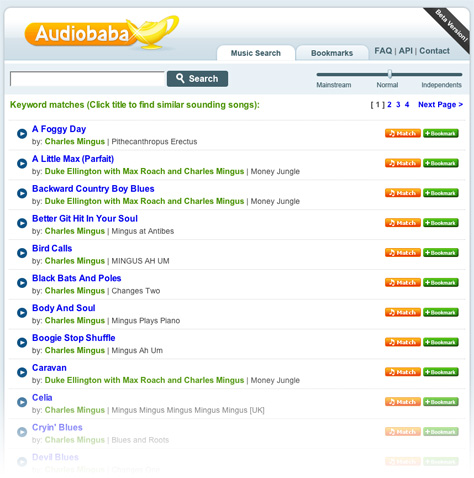
To test the system I tried to find matches for Charles Mingus’ very unique sounding “Boogie Stop Shuffle”. Audiobaba returned many songs from the jazz genre that indeed matched many qualities such as instrumentation, tempo, style and mood. A few other searches yielded similar successes while others were mixed.

If you feel a song isn’t related, you can click the “Thumbs Down” button to help Audiobaba refine their results. They should really change the name of this button since “thumbs down” really implies that I don’t like a song. Perhaps allowing user to use a sliding scale from Great Match to Poor Match would be better as it allows for positive as well as negative user feedback.
A cool feature is the RSS Songfeed. When you find a song you like, you can subscribe to it’s RSS feed. When new songs show up that match your song, they will automatically appear in the feed. Audiobaba also allows you to bookmark tracks. However, since there is no login for the site, if you switch computers or browsers, you wont be able to access your bookmarks. Many of the independent tracks are provided as free downloads and they also provide links to purchase songs on Amazon, Buy.com and iTunes.
Audiobaba is still in Beta but needs to make some improvements to the search functionality and UI. Simple misspellings will return no results and the system does not provide a Google-style “Did you mean X?” feature. While I do like the idea of universal search, they need to provide a better way of filtering the results by songs and artists. For instance, if I search for “The Doors”, I need skip ahead many pages since results are provided in alphabetic song format. While this results format makes sense for all songs by a selected artist, its a real pain when just searching for a specific artist. There are also some funky AJAX problems such as strange linking and back button behaviors.
Despite its faults, I found myself having lots of fun playing around with Audiobaba. Their unique approach to music discovery, coupled with a simple UI creates an addicting user experience.
Project Playlist Review
 Project Playlist is a perfect example of how access to free music, combined with MySpace distribution often trumps good user experience and design. Based on some analysis using Compete statistics, blogger David Porter shows a massive expansion of PP’s user base since the beginning of the year. Further analysis using Comscore shows similar growth. PP is a free service and music search engine that allows users to find mp3 files from around the web an add them to their own playlists. Once a playlist has been created, you can embed it into any web page or blog to share it with the world. PP’s about page states that:
Project Playlist is a perfect example of how access to free music, combined with MySpace distribution often trumps good user experience and design. Based on some analysis using Compete statistics, blogger David Porter shows a massive expansion of PP’s user base since the beginning of the year. Further analysis using Comscore shows similar growth. PP is a free service and music search engine that allows users to find mp3 files from around the web an add them to their own playlists. Once a playlist has been created, you can embed it into any web page or blog to share it with the world. PP’s about page states that:
“More and more, music is being released on the web for promotional purposes (through mp3 music blogs, artist websites, label websites and other sources), or for free distribution by the artist or label in order to drive concert and merchandise sales.”
Well that is true and makes them sound like they are on solid legal ground but PP’s search engine does not limit itself to just legal files and predominantly returns search results of mostly illegal files.
Registration & Profile
Like most Music 2.0 sites, PP has a fairly straightforward registration process. After completing registration, you can configure your profile page which includes the standard fare such as My Playlists, General Info, My Blogs, Buddies, Music Interests, etc. The overall design and layout of the page, like most of the site, is a complete mess. Aside from poorly organized information blocks, the mostly monochromatic UI mixes a variety of navigation styles (links, tabs, buttons, etc.) which drastically impairs the site’s usability. Additionally there is no way to customize the layout and colors of your profile page.
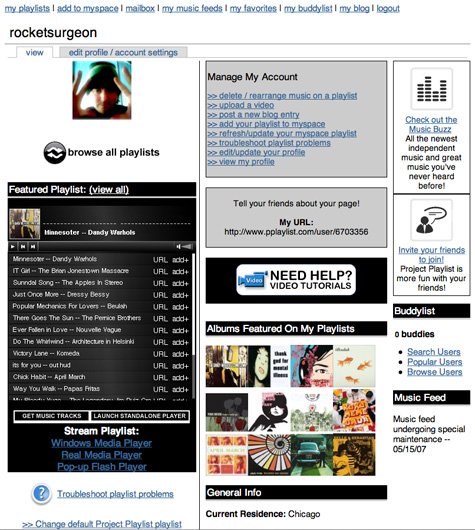
Finding Music
Instead of taking up half the site header area with branding, PP should introduce a persistent search box. The current implementation requires you to click the “search for music” tab every time you want to perform the key task of the site. The search engine allows you to search for artists and songs across the web (blog and concert search is coming soon).
The engine returns a paltry 10 results per page (gotta get those page views up for advertisers like the aircraft broker who showed up on a search for Beulah) which seem to be sorted by relevance. It would be great if there was a way to get an alphabetic sort here as well since finding a single song from a popular artist can be challenging. Each result has an associated Play and Add button. When you click the play button the song automatically begins playing inline. Why the page displays another play/stop button instead of using the one you originally clicked escapes me. If you click another play button on the page, the first song continues to play as the second one begins - a great feature if you do a search for Row Your Boat but otherwise really annoying.
Browsing user playlists is a pretty futile task with PP. Basically PP provides just a single, paginated list of user playlists. There is no way to search playlists or browse them by theme, genre, etc. Additionally there is no way to browse other users in any way other then stumbling upon them.
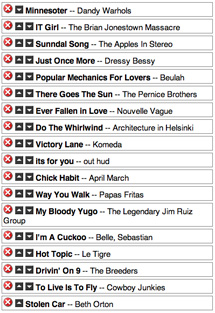 Creating & Managing Playlists
Creating & Managing Playlists
Once you have found a song you like in your search results, you can click the “+” button to add it to a playlist. Instead of using DHTML or AJAX widgets to do this, PP takes you to a page that asks you to test to see if the song plays. Once you confirm, it takes you to another page where you select which playlist (if you have more than one) the song should be added to. You are then taken to a confirmation page which has a link back to the original search results page. Managing your playlist order is fairly straightforward. You can use in-page drag-and-drop editing or use up and down arrows. From what I can tell, there is no ability to set a playlist as private. PP also doesn’t provide good tools for when a song in your playlist is deleted from the Internet (since site owners are have to pay for their bandwidth usage, songs on popular playlists will likely be removed due to the traffic burden). Instead of automatically removing the song from your list, it will stay there and simply not play - you need to manually replace the song with a valid copy.
Sharing Playlists
PP provides multiple methods to access and share your playlists. You can play your list in in Windows Media Player, Real Player and a Flash player. More interesting is the ability to subscribe to your list as an iTunes podcast which then allows you to put the playlists and individual tracks on your iPod or hard drive. PP also provides simple methods to generate code for an embedded player on MySpace, Facebook or other blogs and web pages. You can partially customize the player’s colors and set the playlist for autostart (please don’t) and random shuffle. You can adjust the width of the player by tweaking the code.
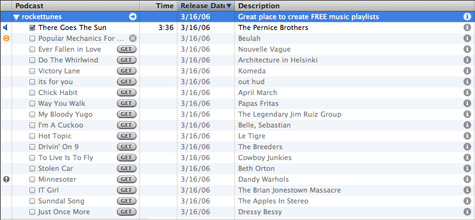
Conclusion
There are many other playlist creation services out there such as Finetune, iMeem, and Fiql that have done a great job at balancing a great user experience with solid content. These services either require you to use an existing catalog, use files within the network, or upload your own files. PP’s approach of creating playlists based on links to songs on the Internet is a worthwhile concept though legally murky and prone to a host of content management and metadata issues. Perhaps it is this simplicity of this approach that is helping PP gain so much traction. Now if they can just invest some of the money from the massive amount of ads on the site into richer features and a better user experience they could really be onto something.
Here is a playlist i created in Project Playlist:
Finetune Review
 I finally got a chance to spend some time playing around with Finetune, an free, cross-platform service that lets you find, create, and share streaming “playlists”. The term “playlist” is a bit of a misnomer here since Finetune’s DMCA compliance dictates that you need at least 45 songs, no more than three songs per artist, no control over the playback order, and limited track skipping. So instead of traditional playlists, you can think of them as programmable streaming stations. Finetune has two major offerings. The first is a browser-based service that allows you to find, create and share playlists. The second is Finetune Desktop, an Adobe Flash/Apollo based desktop player (currently in preview).
I finally got a chance to spend some time playing around with Finetune, an free, cross-platform service that lets you find, create, and share streaming “playlists”. The term “playlist” is a bit of a misnomer here since Finetune’s DMCA compliance dictates that you need at least 45 songs, no more than three songs per artist, no control over the playback order, and limited track skipping. So instead of traditional playlists, you can think of them as programmable streaming stations. Finetune has two major offerings. The first is a browser-based service that allows you to find, create and share playlists. The second is Finetune Desktop, an Adobe Flash/Apollo based desktop player (currently in preview).
Registration & Profile
Registering for Finetune is free and and fairly painless process. Once you have registered, you can customize your profile and begin exploring music. Your profile provides quick access to the Finetune Player, favorite artists, albums, playlists, tags and friends (though it would be nice to see who has added you as a friend). Finetunes provides accessible URLs for easy linking to your profile. You can see a “Fingerprint” - a list of artists based on your music taste. As a friendly gesture to closet Britney fans, the list is editable so you can prevent other users from seeing all your guilty pleasures.

Finding Music
Finetune currently has over two million songs from major labels. Since the service is technically not play-on-demand, there is significant content from artists such as The Beatles and Led Zeppelin currently unavailable on the major subscription/download services. The site provides basic search functionality that allows you to search across artists, albums, playlists, tags, tracks, and users. However, in a major usability snafu, the service doesn’t employ a persistent search box, so you need to click the search tab every time you want to perform a search. This can make building a custom playlist a very tedious process. Instead of providing a top level genres/subgenre hierarchy, Finetune utilizes the now ubiquitous tag cloud for browsing content.
Stations
When you visit an artist page, you have the option of playing “Artist Radio”, a feature common to many existing services. But Finetune goes a step beyond - once a tag has been applied by user to content a certain number of times, Finetune automatically creates a “Tag Radio” station. This is a great for music discovery because you now have access to stations based on genres, subgenres, moods, instruments, etc. You also have access to “Favorite Artist Radio”, which creates a custom station based on artists you have marked as a favorite.
When you mark an artist or playlist as a favorite, you can go to your favorites for quick access to individual artist stations and user playlists. For some reason, Finetune allows you to play Tag and User “Favorite Artist” stations but does not provide a mechanism to save them as a favorite for quick retrieval.
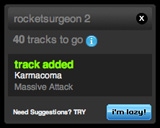 Creating & Managing Playlists
Creating & Managing Playlists
Building playlists is fairly straightforward. Once you find a song you like you can listen to a 30-second sample or directly add it to one of your playlists. Once a playlist has been activated, it appears on the left column of the screen. You need at least 45 songs, so as you add songs, the playlist widget lets you know how many songs you have to go. 45 songs is much more than it sounds, and the process can be quite tedious (especially due to poor search usability). However, once you add at least three artists to a playlist, Finetune provides an “I’m Lazy” feature that will automatically generate the rest of the playlist based on related artists. You can then review the track selections and keep or delete individual items. You can continue this process until you are satisfied with the playlist. Another great feature is the ability to add custom artwork to your playlists instead of using the traditional four-square or album-stack approach used on other major services.
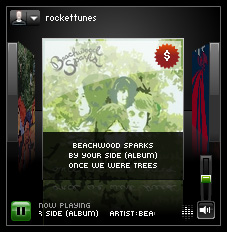 The Player
The Player
Finetune simply has one of the best looking UIs I have seen, though its missing some critical features. Good sized album art is displayed on a black background and the “wet floor” effect. Artwork animates in as you move from track to track (similar to the iTunes album art viewer). Mousing over the album reveals metadata and a purchase link. If you listen to a 30 second sample while listening to a playlist or station, the current song fades out and visually recedes into the player background and the art for the sample comes in and begins to play. When the sample has finished, playback of your original stream automatically resumes. The player also provides quick access to your playlists and artist stations via a pull down menu. The artist station search function can use some help though as it does not provide traditional results and interrupts playback of your current stream.
Unfortunately, the player does not allow you to add the current song to a playlist, which may not be important when listening to your own lists but is essential when listening to other lists or stations. The player should also provide a means for adding the current artist or album as a favorite instead of needing to navigate to the respective artist or album page.
Sharing Playlists
Its very easy to place any user-created playlists on you blog, website or MySpace page. You can see my “Rocketunes” playlist embedded on the right column of this page. As with many Flash-based widgets, I wish there was a way to control the size of the player when embedding in other sites as the column dimensions may not be wide enough to fit the full size player.
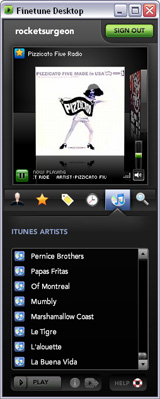 Finetune Desktop
Finetune Desktop
The embedded player concept has many drawbacks. First the only way to listen to the music is to keep the page open in a browser window. For many people, especially developers, this can cause major headaches. The embedded player in the Finetune service works great until you use the back button. That’s where Finetune Desktop comes in. Finetune just launched a preview release of this Adobe Apollo application a few weeks ago. Theoretically it works on both PC and Mac though I have had some installation issues on the Mac.
All the key features of the web service are packed into this beautifully designed player. Icon tabs let you quickly access you playlists, artist stations, tag stations and history. integrated search allows you to find new artist stations and other content. But one of the coolest features is that Finetune will automatically scan your iTunes collection and provide you with a list of artists from you library. you can then select these artists to hear their artist station (if finetune has matching results in their catalog). Like the web player, the desktop player needs to incorporate the ability to add songs to a playlist in addition to tagging and favoriting artists without visiting their web page.
Conclusion
After playing around with Finetune for a while, i really believe they have built a great vehicle for music discovery that rivals Pandora. Once they work out some of the findability issues and devise a way to actually block artists from your streams they have a great opportunity to become the premier service in this area.





 Del.icio.us
Del.icio.us Last.fm
Last.fm Strands
Strands Virb
Virb YouTube
YouTube